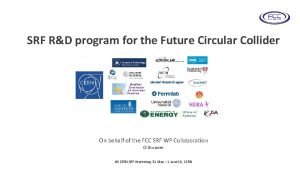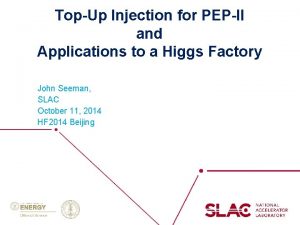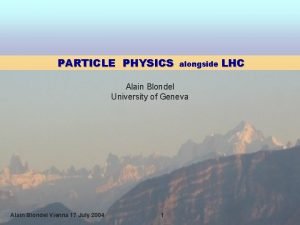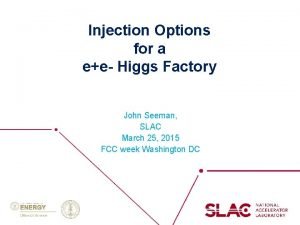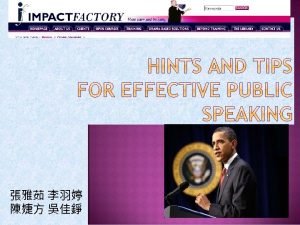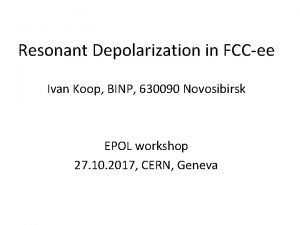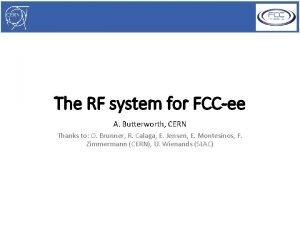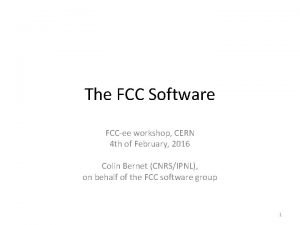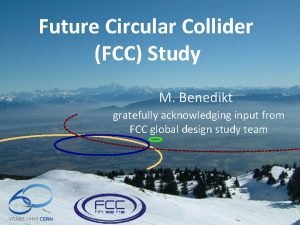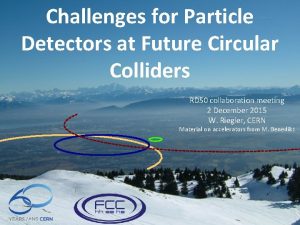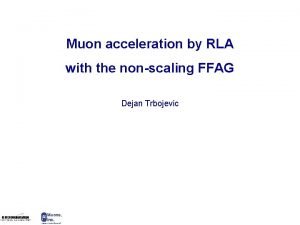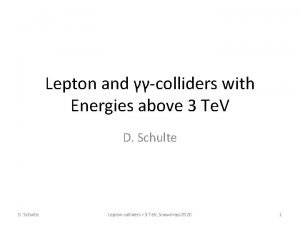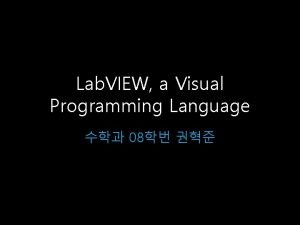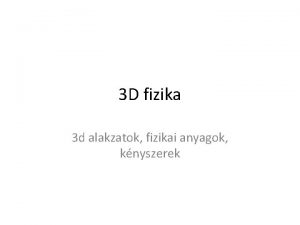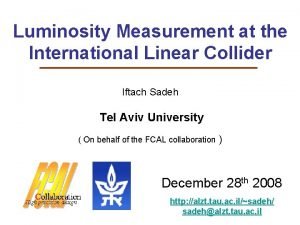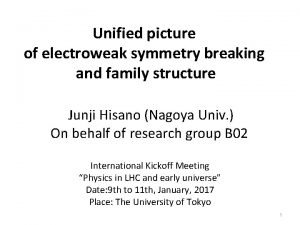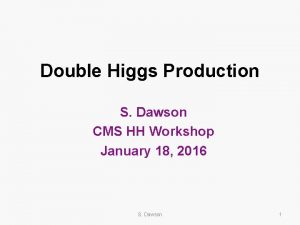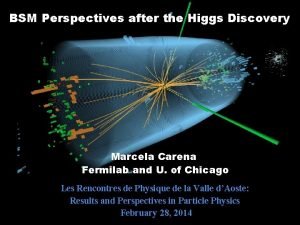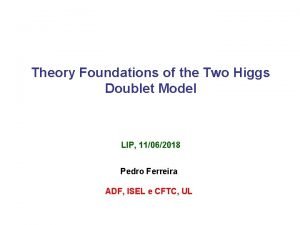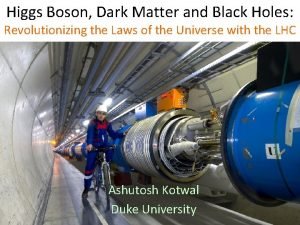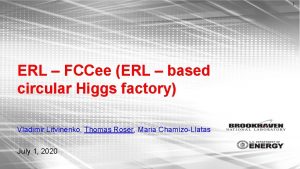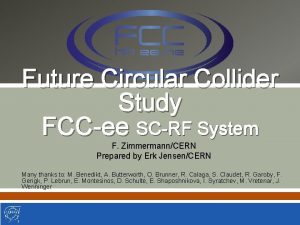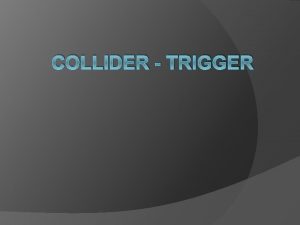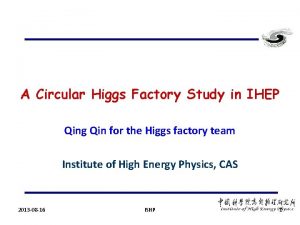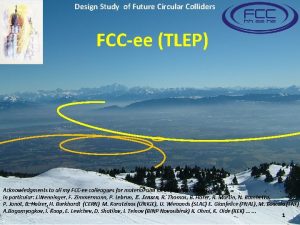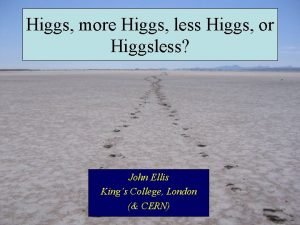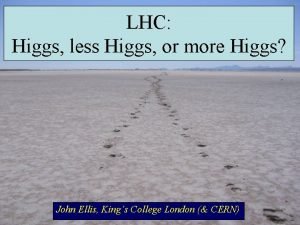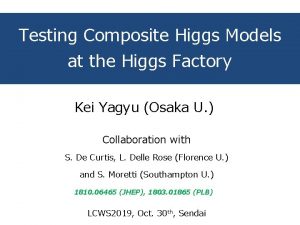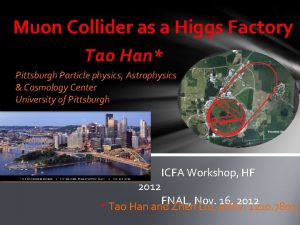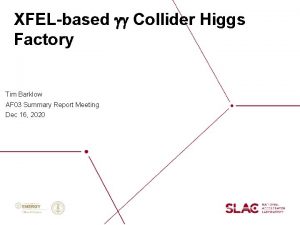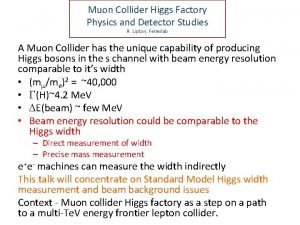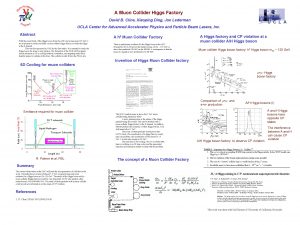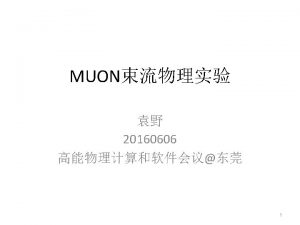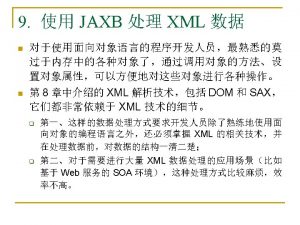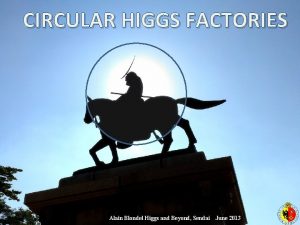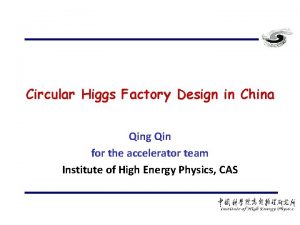Future Circular Collider Study FCCee as Higgs Factory









![b* evolution Higgs Hunting 2014 - Paris - J. Wenninger b* [m] year SPEAR b* evolution Higgs Hunting 2014 - Paris - J. Wenninger b* [m] year SPEAR](https://slidetodoc.com/presentation_image_h2/fb6e9ad652759eb9de7edc6e106bc8d7/image-10.jpg)














- Slides: 24

Future Circular Collider Study FCC-ee as Higgs Factory 23/07/2014 Jörg Wenninger CERN Beams Department Operation group - LHC Acknowledgments to my FCC-ee colleagues from CERN and BINP 1

Future Circular Collider study q pp collider (FCC-hh) – 50 Te. V* – defines infrastructure. 23/07/2014 Higgs Hunting 2014 - Paris - J. Wenninger Ø B = 16 T 100 km Ø B = 20 T 80 km collider (FCC-ee/TLEP) – 40 -175 Ge. V* – as potential intermediate step. q e+ e- q e-p option. q Organized as an international collaboration. q Infrastructure in Geneva area. CDR and cost review for the next European Strategy Update in 2018 *beam energy 2

23/07/2014 Higgs Hunting 2014 - Paris - J. Wenninger Physics goals of FCC-ee The machine will be optimized for operation at 120 Ge. V All energies quoted in this presentation refer to BEAM energies 3

Layout q 1, q 8 2 or 4 experiments. or 12 Long(er) Straight Sections (LSS): L 1500 m (some flexibility). 23/07/2014 Higgs Hunting 2014 - Paris - J. Wenninger o Injection, beam dump, RF, wigglers. RF must be distributed. q Circumference 80 to 100 km. o Arc bending radius r = 11 km. q 2 rings. o Layout and design of common sections to be defined. o The rings should be side-by-side: polarization, vertical emittance. o Machine should be planar: polarization. The layout is far from finalized, it must be compatible with all options (ee, pp, ep) 4

Synchrotron radiation power q The maximum synchrotron radiation (SR) power PSR is set to 50 MW per beam – design choice power dissipation. defines the maximum beam current at each energy. 23/07/2014 Higgs Hunting 2014 - Paris - J. Wenninger Note that a margin of a few % is required for losses in straight sections. r = 3. 1 km r = 11 km VRF ~35 GV VRF ~10 -11 GV 5

Luminosity H 1 23/07/2014 Higgs Hunting 2014 - Paris - J. Wenninger Hour-glass F 1 Crossing angle 2 F Beam-beam parameter 6

Beam-beam parameter beam-beam parameter x measures the strength of the field sensed by the particles due to the counterrotating bunch. q The 23/07/2014 Higgs Hunting 2014 - Paris - J. Wenninger q Beam-beam parameter limits are empirically scaled from LEP data (also 4 IPs). In reasonable agreement with first simulations for FCC ee The beam-beam limit may be raised significantly with Crab-Waist schemes ! 7

Beamstrahlung photon emission at the IPs, ‘Beamstrahlung’, can become a lifetime / performance limit for large bunch populations (N), small hor. beam size (sx) and short bunches (ss). g e 23/07/2014 Higgs Hunting 2014 - Paris - J. Wenninger q Hard e r : mean bending radius h : ring energy acceptance at the IP (in the field of the opposing bunch) Lifetime expression by V. Telnov q To ensure an acceptable lifetime, r h must be sufficiently large. o Flat beams (large sx) ! o Bunch length ! o Large momentum acceptance of the lattice: 1. 5 – 2% required. o LEP had < 1% acceptance, Super. KEKB ~ 1 -1. 5%. 8

IR parameters the IP the smallest possible b* must be obtained – see L formula. The target for b*y is set to 1 mm. Such a small b* requires a local chromaticity correction scheme. 23/07/2014 Higgs Hunting 2014 - Paris - J. Wenninger q At o Design taken over from linear collider IR. But with the complexity that the beam does not pass the IR only once effects of optical aberrations is very critical. o Requires bending magnets close to the IP SR fan ! q The distance between IP and front-face of the first quadrupole is currently set to L* ≥ 2 m (Super. KEKB ~1 m). o Acceptance for experiments, luminosity measurement. To be studied. The combination of very small by* and large acceptance is a challenge for the optics design ! 9
![b evolution Higgs Hunting 2014 Paris J Wenninger b m year SPEAR b* evolution Higgs Hunting 2014 - Paris - J. Wenninger b* [m] year SPEAR](https://slidetodoc.com/presentation_image_h2/fb6e9ad652759eb9de7edc6e106bc8d7/image-10.jpg)
b* evolution Higgs Hunting 2014 - Paris - J. Wenninger b* [m] year SPEAR PETRA PEP, BEPC, LEP TRISTAN DORIS CESR-c, PEP-II CESR F. Zimmermann BEPC-II DAFNE KEKB 6 mm FCC-ee Super. KEKB 1 mm 23/07/2014 0. 3 mm Super. KEKB will be a FCC-ee demonstrator for ceratin optics aspects ! 10

Main baseline parameters q Different Higgs Hunting 2014 - Paris - J. Wenninger o optimizations are possible within DL/L ~30 -50%. No. bunches bunch population, emittances … Parameter Z W H t LEP 2 E (Ge. V) 45 80 120 175 104 1400 152 30 7 4 No. bunches 16’ 700 4’ 490 1’ 330 98 4 b*x/y (mm) 500 / 1 1000 / 1 1500 / 50 ex (nm) 29 3. 3 1 2 30 -50 ey (pm) 60 7 2 2 ~250 0. 03 0. 06 0. 09 0. 07 28 12 6. 0 1. 8 0. 012 I (m. A) xy L (1034 cm-2 s-1) 23/07/2014 q The actual intensities and luminosities will be lowered somewhat by SR losses around the experimental regions (change < 10%). 11

Luminosity Number of bunches : ~17’ 000 at 45 Ge. V ~100 at 175 Ge. V 23/07/2014 Higgs Hunting 2014 - Paris - J. Wenninger The large number of bunches at Z, W & H requires 2 rings / IP CEPC* (*) Y. Wang FCC kickoff 12

Luminosity lifetime q Lifetime from luminosity depends on radiative Bhabha scattering total cross-section see 0. 15 (b) for h=2% independent of energy. 23/07/2014 Higgs Hunting 2014 - Paris - J. Wenninger Lifetimes down to ~15 minutes. Continuous injection (top-up) nip = 4 13

23/07/2014 Higgs Hunting 2014 - Paris - J. Wenninger Performance overview CEPC (2 IPs) High potential of the rings at ‘low’ energy (includes ZH) ILC has a TDR while FCC aims for a CDR in a few years – ILC is evidently more advanced in demonstrating its ‘feasibility’. 14

Single ring option q With a single ring electrostatic fields must be used to separate and recombine the beams. ‘Pretzel’ schemes were used at many colliders (CESR, LEP, Spp. S, Tevatron). 23/07/2014 Higgs Hunting 2014 - Paris - J. Wenninger q Such LEP Pretzel scheme Design: k=36 Operation: k=8 Not the baseline option for FCC-ee ! 15

Double ring IR 23/07/2014 Higgs Hunting 2014 - Paris - J. Wenninger q Large crossing angle – nano-beam / crab-waist concepts. o Favorable from the beam-beam perspective larger x, larger L. o Strong dipoles near IPs synch. radiation, machine-detectors interface. o Bunch length ss >> b*y , ss 4 -6 mm ( RF frequency of 400 MHz). o Luminosity loss from large crossing angle ( F <<1) must be compensated by smaller emittances and higher bunch currents. Overlap region ~ b*y<< ss DAFNE H~1, F << 1 Super. KEKB 2 F ~10 -40 mrad A new parameter set for 2 F ~ 30 mrad will be prepared to replace the current baseline 16

IR layout – double ring 23/07/2014 ½ IR designed by BINP q Issues x (m) Higgs Hunting 2014 - Paris - J. Wenninger IP q = 30 mrad that have to be tackled: 2 m s (m) o Dynamic aperture (momentum acceptance), we are not there… o Strong dipoles SR radiation power ~ MW / beam / IR. For crossing angles and local chromatic corrections (the later also applies for single ring) – careful optimization required. o Machine-detector interface (solenoid, L monitoring…). o Transverse size tunnel diameter. 17

Super. KEKB IR q IR layout of Super. KEKB – the only straight thing is the tunnel. of the beam paths local chromatic corrections. Higgs Hunting 2014 - Paris - J. Wenninger q ‘Wiggling’ K. Oide H. Sugimoto q The last focusing quadrupoles are installed deep inside the BELLE detector. 23/07/2014 o Shielded from the BELLE solenoidal field with antisolenoids. 18

23/07/2014 Higgs Hunting 2014 - Paris - J. Wenninger SC RF System 19

Injection the collider ring(s), a booster of the same size (same tunnel) must provide beams for top-up injection. 23/07/2014 Higgs Hunting 2014 - Paris - J. Wenninger q Besides o Same size of RF system, but low power (~ MW). o Top up frequency ~0. 1 Hz. o Booster injection energy ~20 Ge. V. o Bypass around the experiments. q Injector o complex for e+ and e- beams of ~20 Ge. V. Super-KEKB injector ~ almost suitable (needs boost of energy). 20

Polarization Two main interests for polarization: q Accurate energy calibration using resonant depolarization measurement of MZ, GZ, MW 23/07/2014 Higgs Hunting 2014 - Paris - J. Wenninger o Nice feature of circular machines, d. MZ, d. GZ ~ 0. 1 Me. V q Physics o Precession frequency E with longitudinally polarized beams. Transverse polarization must be rotated in the longitudinal plane using spin rotators (see e. g. HERA). Scaling the LEP observations : polarization expected up to the WW threshold ! LEP Integer spin resonances are spaced by 440 Me. V: energy spread should remain below ~ 60 Me. V 21

Polarization build up q Transverse polarization build-up (Sokolov-Ternov) is very slow at FCC-ee (large bending radius r). tp 190 hours @ Z Build-up is ~40 times Higgs Hunting 2014 - Paris - J. Wenninger slower than at LEP may lower tp to ~12 h, limited by s. E 60 Me. V and power. q Wigglers o 1 hour OK for energy calibration (few % P sufficient) q Longitudinal polarization: levels of ≥ 40% required on both beams. Excellent resonant compensation needed. o 23/07/2014 Due to power loss the wigglers can only be used to pre-polarize some bunches (before main injection). Expected to be difficult, requires spin rotators or snakes, most likely only possible at lower intensity and luminosity. 22

CEPC Higgs Hunting 2014 - Paris - J. Wenninger Y. Wang at FCC kickoff meeting 54 km ~ 2 LEP/LHC (centre-of mass !) 23/07/2014 A lot of synergies between FCC-ee and CEPC ! 23

Conclusion q FCC-ee is designed to be a Z, W, H and t factory – with design emphasis on H - 120 Ge. V / beam. CDR to be prepared for ~2017. 23/07/2014 Higgs Hunting 2014 - Paris - J. Wenninger q This machine has a lot of potential, but also many challenges: o high power and high gradient RF system, o loads of synchrotron radiation, o a double ring and a booster (plus an injector chain), o optics with very low b*, large acceptance, o low lifetime and beamstrahlung, o 4 experiments to serve… and much more. q We can build on the experience of past colliders, and soon from Super. KEKB that aims for similarly pushed IP focusing. q This is just the beginning, but the potential is high ! 24
 Martinello colider
Martinello colider Scence
Scence Cern geneva
Cern geneva Higgs factory
Higgs factory Java factory factory joke
Java factory factory joke Fccee
Fccee Fccee
Fccee Fccee
Fccee Fccee
Fccee Future perfect continuous tense sentences
Future perfect continuous tense sentences Future perfect simple and continuous
Future perfect simple and continuous Fcc collider
Fcc collider Fcc collider
Fcc collider Bnl
Bnl Muon collider
Muon collider Particle collider
Particle collider Unity sphere collider
Unity sphere collider Hadron collider
Hadron collider Hadron collider
Hadron collider International linear collider
International linear collider Higgs singlet
Higgs singlet Higgs singlet
Higgs singlet Marcela carena
Marcela carena Higgs doublet
Higgs doublet Higgs boson black hole
Higgs boson black hole
